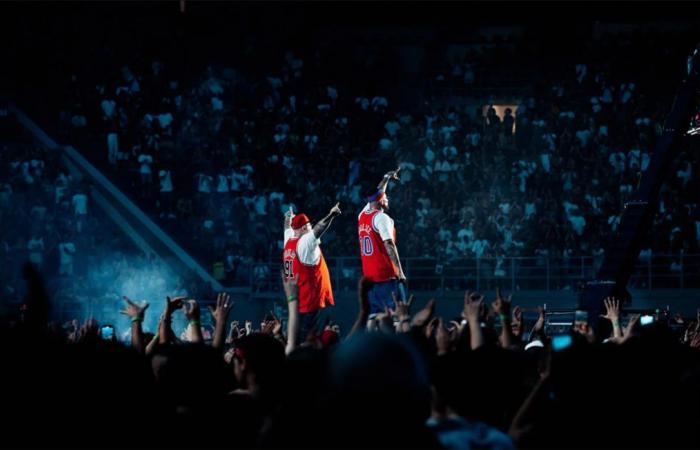Who would have ever said in 2003 that the Milanese project born from the ashes of the Sacre Scuole would become, in twenty years, the most important rap group in the history of the genre in Italy. Of course, someone could rightly object that no one will ever be on the same level as pioneers like Sangue Misto, but Club Dogo were – and still are, given that they officially reformed this year by releasing an album – something more. In this case we are not talking about quality in the strict sense, but rather about horizontal breadth (the audience reached) and vertical breadth (the length of the career), two characteristics that no rap group in Italy can share with Dogo.
Ten years have passed since that debut called My Fist capable of overwhelming Italian CD players and car radios (particularly from the north-west) at that We are no longer the ones from Mi Fist, the ironic farewell before ten years of silence. And then a sudden return, a few months ago, just in time to take back everything that had been cultivated with those seven records that marked a fundamental era of Italian rap, the one that brought the genre from the underground into the mainstream definitively .
Photo: Edoardo Anastasio
Photo: Edoardo Anastasio
Photo: Edoardo Anastasio
It is no coincidence that all the guests (Elodie, Marracash, Sfera Ebbasta, Lazza, Arisa, Giuliano Palma, Coez, J-ax. Alborosie, Vincenzo da Via Anfossi and Emi the uncle) present at the trio’s first time at San Siro – an event that is directly inscribed in the history of Italian rap – took the floor even just in passing to thank those who Lazza and Sfera Ebbasta defined from the stage fathers (“You are my parent 1, parent 2 and parent 3”, jokes Lazza after lending himself to the piano for Lisa). When they left, despite a career full of commercial successes, Dogo could never have dreamed of closing 10 dates at the Forum (here if you want to know how it went) and one at San Siro, but the work done by their “children”, those very Sfera and Lazza who came here to pay their respects and who in the last 10 years have revolutionized the scene making urban (whether it’s trap or rap) the most listened to genre in Italy, has served to ensure that the history of Dogo has settled perhaps in a more subtle way than we could have imagined in the cultural substratum of the country.
The place is therefore Milan, as always in the trio’s career, celebrated here in every possible way, from the stage showing a corner of the city and the red metro to panoramic videos of the metropolis, from early lyrics such as Crazy life to the most recent Alone in Milan with Elodie, contained in the latest album, Small. The place, more precisely, is San Siro, this evening well populated by a transgenerational audience composed of those who discovered Dogo thanks to collaborations with the most contemporary trap artists and those who were there from day one, from the first bars of My Fist (“Sa sa, I test the microphone, never give up / brain on, TV off, I explode on the boom bap”, to be exact). The protagonists are them – Guè, Jake la Furia, Don Joe -, Club Dogo, mainstream Italian culture from the early 2000s to today put into rap.
Photo: Edoardo Anastasio
Photo: Edoardo Anastasio
Photo: Edoardo Anastasio
In fact, it is no coincidence that on the screens, during the various interludes that divide the show into six different sections, images of the gigantic short circuits present in the country’s culture and in the careers of the Dogos flow. In the video clips there are Mario Giordano, straight from Out of the corewho first mentions the various putative fathers of the history of Italian rap (from Kaos to Sangue Misto, from Articolo to Sottotono) and then dives back into the role of villain of Rete 4 who hates rap for its violent and misogynistic lyrics (in a game of massacre that recalls CCCP with Andrea Scanzi in Berlin), but also Briatore who quotes the lyrics of Briatoriand photos and videos in which Silvio Berlusconi, Lapo Elkann, the porn star Elena Grimaldi appear in no particular order, the photo shoots of the calendars of Maxor rather all that Italian culture which is the product of Berlusconism and the secret services Wick on Mediaset. And if in the first part of his career this nativity scene of ultra-capitalist figures was the number one enemy of the group – which at the Vile money he had dedicated an album to us – now it is in its own way an integral part not only of the aesthetics, but also of the very experience of Dogo as a group and as individuals. From the flag of the counterculture, the Club Dogo have in fact become the culture itself, with all the complications of the case which at San Siro were celebrated by a proud Dogo public more than ever faithful to the figures of Guè, Jake and Don Joe.
After all, the Dogos have always been so blatantly self-congratulatory that they have always considered themselves part of history, as they already made clear in a title that was both crudely self-deprecating and self-absorbed as We are no longer the ones from Mi Fist. The show is thus rightly a great (self)celebration of a two-decade long career, in which Dogo seize every possible opportunity to remind us and themselves of it (Guè’s continuous smiles reveal a certain emotionality that will return throughout the live). In the live there is a section dedicated to the nostalgia of the steel rhymes of My Fist con Crazy life, Chronicles of resistance, The Ghost Room, Hardboiled, Rap sopranoone on the lighter and more reggae side of the trio (with an introductory video with an interview with Bob Marley, the only moment Really serious of the show, rightly in contrast with the videos of Briatore and Giordano) in which Alborosie and Giuliano Palma come to help for songs like King of the Jungle e P.E.S. – in addition to the beloved Note Killer -, and a section designed exclusively for one of the Club’s dearest brothers, Marracash, who remains on stage for four songs – Briatori, Hello indeed, Born for this, Pure Bogota – marveling with each song at how much the next one is «even more of a mine». “It’s my story, your story,” Jake declares at the beginning of Onceand never as on this night do all the dogofieri planets seem aligned.
Photo: Edoardo Anastasio
Photo: Edoardo Anastasio
Photo: Edoardo Anastasio
In a mix of nostalgia, hip hop militancy and rude nastiness, the three do their duty, rapping the songs without following the stupid trend of cutting the verses to highlight, since there is a need, how important words are in this genre . Whether they are politicized like those of the beginning, or ultra-capitalist like those of the second part of their career, Dogo remain proudly convinced first of all of themselves, even in the choice of songs that have not exactly stood the test of time. «This could no longer be written now» jokes Guè shortly afterwards Briatori, and he’s right: times have changed, and so have the Dogos in their own way. It doesn’t matter whether it’s for better or worse, it’s already history.
Milano finest is the claim that Club Dogo have stuck to their chest since their debut. And in the splendid setting of San Siro they have every reason for such (self)proclamation. For better or for worse, Dogo have reminded us that they are part of the last twenty years of Italian national-popular culture, both as narrators and as protagonists. Twenty years later, seeing them on that stage has an enormous meaning. For the audience present, for them, for rap. Milan is once again a dog pride.






